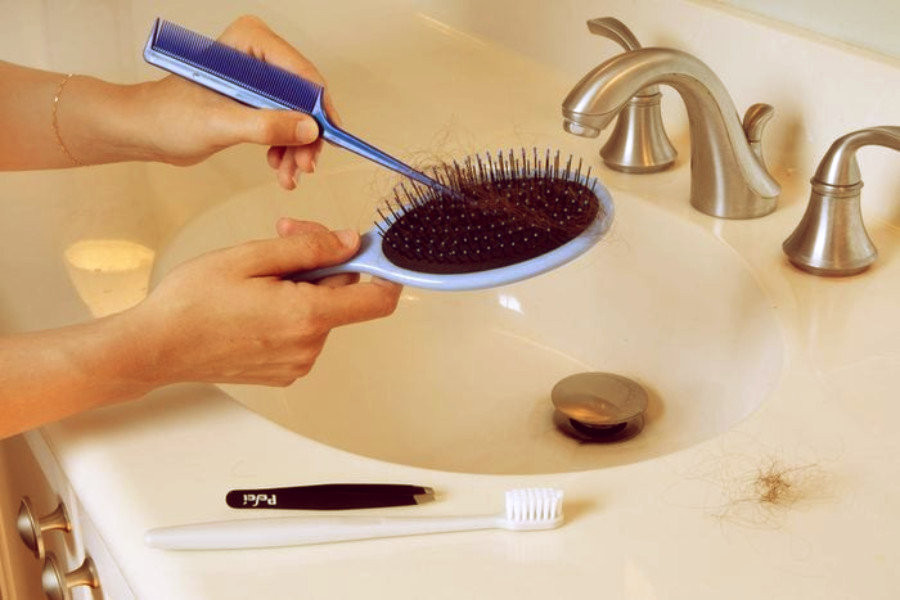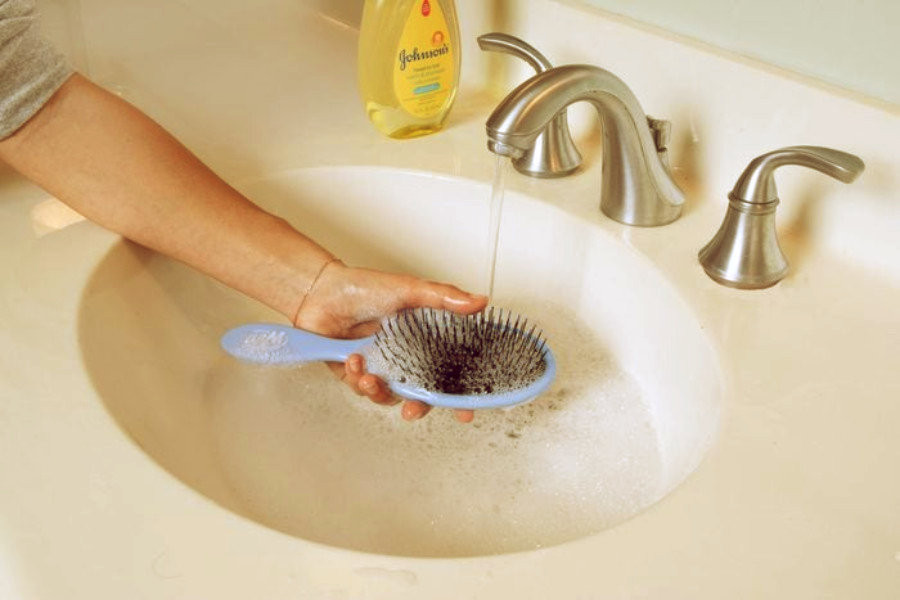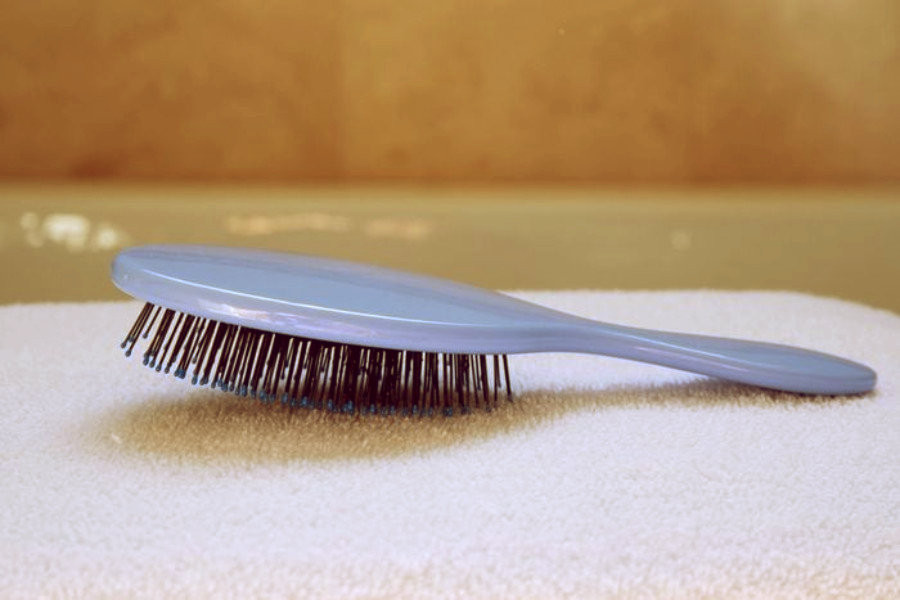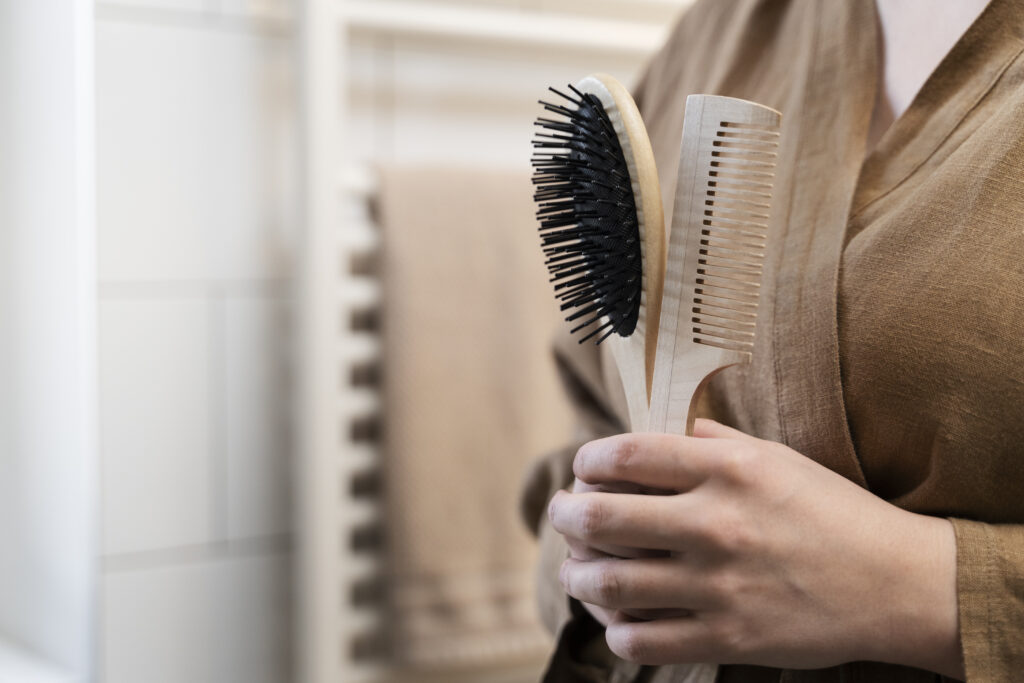Every day and night, we rely on our hairbrush to untangle our clean and unclean hair. But are you giving your trusted tool the attention it requires? Not likely. When you really look at your brush, you might find that the surface is full of lint and dirt, which might make you search for “how to clean a hairbrush.”
To get rid of the oil, dead skin cells, and style products that stick to brushes, you need to clean them. “If the brush isn’t cleaned frequently, it turns clean hair oilier and ultimately dirty again.” Furthermore, bacteria and fungus may gather on the brush and dwell on our scalps.” If you have sensitive skin, it recommends cleaning combs and brushes on a regular basis to avoid itching and possibly clogging hair follicles. If the itch is severe enough, “it might conflict with healthy hair growth.”
Although, there is a right way to clean your brush before you start hacking away at the lint and hairballs that have gathered on it. How often you should clean your hairbrush and when it’s time to get a new one are all covered in this piece of writing.
Why is it important to clean your hairbrush regularly?
The same care should be taken with your hairbrush as you do with your makeup brushes. Hairbrushes become coated with the hair products you use, as well as bacteria, pollutants, dust, sweat, oils, and dead skin cells from your scalp and hair. If you comb or style your hair with a dirty brush regularly, you will be laying dirt back onto your strands and scalp.”
However, keeping a hairbrush thoroughly clean entails more than simply eliminating the hair that accumulates on it. Have you ever seen dusty gray lint or fuzz on your brush? That can be true dust from the environment, along with grime, old product dirt, oils and dead skin cells found within your hair and on your scalp.
If you use a dirty brush, you may deposit buildup on your strands and scalp, making your hair look greasier. Additionally, bacteria and yeast can grow on your hairbrush, posing an infection risk.
How often should you clean your hairbrush?
To prevent the collection of bacteria and dust, clean your hairbrush twice a week, or more frequently if you have dandruff or psoriasis. In fact, if we use a dirty hairbrush, all of the oil and debris will return to our hair, producing dandruff, clogging hair follicles, and increased oil production. Dry shampoo and styling lubricants can gather on a hairbrush over time and be deposited back onto the scalp.
How often should you replace your hairbrush?
It depends on the hairbrush that you use. However, replace your brush if the bristles or prongs are breaking off, bent, or damaged, or if the body is flaking or cracking.
What you need to clean your hairbrush
Properly cleaning your brush requires only a few basic tools and items that you likely already possess. For instance,
Tools:
- Cotton Swab
- Pintail Comb
- Tweezers
- Toothbrush
- Sink or Bowl
- Towel
Materials:
- Gentle Shampoo (Without Conditioners)
- Isopropyl Alcohol (Rubbing Alcohol)
- Disinfecting Spray
- Baking Soda
How to clean a hairbrush?
The first step in learning how to clean a hairbrush is to remove any hair that has become entangled within it. Either a comb or a brush-cleaning tool may be used for this purpose. Subsequently, the following stages will depend on the bristles on your brush and the handle material. In general, hot water and mild dishwashing soap or an antimicrobial shampoo will remove skin particles and product residue.
1. Remove hair from the brush

Start by pulling close-to-the-top hair upwards with your fingertips. Then, remove hair from the brush’s base using a pintail comb, tweezers, or a brush-cleaning tool.
2. Create a cleaning solution
Fill a basin or your bathroom sink halfway with warm water and a few drops of shampoo or mild dishwashing solutions. Then, swirl your fingers together to make suds.
3. Let it soak

If you using a plastic or laminate brush, you can dip it in the soap bubbles. Thus, you may observe that some of the hair on the surface of your brush is beginning to come loose, and your sink may appear cloudy. Soak the hairbrush for approximately 10 minutes.
If you have a brush with natural bristles or a wooden handle, you should be more careful when cleaning. To avoid damage, avoid dipping your hairbrush in water. Instead, hold it up so that only the bristles are submerged in water. Give the bristles ten minutes to submerge.
4. Scrub
Don’t fret; a hairbrush may be used to clean more than your hair. It’s helpful to clean the hairbrush’s base with a toothbrush.The use of natural fibers can further enhance skin protection.Baking soda can help remove stubborn grime from a dirty hairbrush before cleaning.
5. Rinse
Make sure your hairbrush is completely dry when you’ve finished cleaning it. Adding vinegar to the final rinse aids in sanitation.There are more things you can do around the house with vinegar.
6. Dry

Place your toothbrush on a clean cloth, bristles down, and let it to dry naturally.
Pro tip
Take a spray bottle and mix equal parts isopropyl alcohol and water. Consequently, this will make your brushes really clean. After you’ve completed the preceding steps, spray your brush with water and allow it dry naturally.
How to clean a hairbrush with a wooden handle
If your hairbrush has a wooden handle, you’ll want to be extra careful, much like with natural-bristle brushes. Specifically, if you use too much product or get it wet, you may find that your brush begins to warp.
- Remove any product buildup and hair with your fingers, a pintail comb, or tweezers.
- Run cool water over the brush, bristles down, before getting the handle wet.
- Apply a tiny amount of shampoo or dish detergent on the bristles and gently rub the shampoo between each bristle.
- Rinse with cold water.
- Hang the brush upside down with the bristles facing down to dry.
How to Clean a Hairbrush With Synthetic Bristles
Here are some tips on how to clean a brush with synthetic bristles (like nylon).
- To remove unnecessary hair and product residue, use fingers, or a pintail comb.
- Place the bristles of the brush in a big dish of lukewarm water and soak it.
- Take two minutes before mixing baking soda into the water and washing the brush carefully to get rid of all product accumulation.
- If any extra product remains, apply shampoo to a bamboo toothbrush and clean the brush to make it easier to get around the bristles
- Take the brush from the water and place it to dry, bristles down.
How to Clean a Hairbrush With Natural Bristles
Although the processes are similar, there are numerous significant differences between cleaning a brush with natural bristles (such as boar hair) and one with synthetic bristles.
- Using your fingers, a pintail comb, or tweezers, remove any hair and product accumulation.
- Fill a large basin halfway with cold water, add a drop or two of shampoo, and soak the brush bristles down.
- Apply shampoo gently to the bristles and carefully rub the shampoo between each bristle with your hands.
- Rinse carefully with cold water.
- Once clean, remove the brush from the water and put it on a towel with the bristles downward to dry.
The Bottom Line

If you use a hairbrush every day, attempt to deep clean it once a week. Moreover, to complete this procedure, use antibacterial soap or sulfate-free shampoo, and always dry your brushes upside down. This will help to keep bacteria, oil, and building materials from spreading from brush to strand and vice versa.
Also read: A Comprehensive Guide to Cleaning a Hairbrush
FAQ
1. Why is there gray fuzz in my hairbrush?
Prepare to feel disgusted (or stop reading now if you have an upset stomach!). The gray fuzz you see is a combination of dead skin cells, sebum (also known as hair oil), and old hair product, as well as a little dust and grime.
2. Why are there so many hairs in my hairbrush?
Hair loss is a natural part of life, and it’s inevitable that you’ll have some hair from your styling products stuck in your brushes. Up to one hundred hairs fall out daily, and some of them inevitably wind up in your toothbrush. But if you keep up with the cleaning, there won’t be any clutter.
3. How frequently should your hairbrush be replaced?
It is dependent on both the type of brush and its quality. Hairbrushes made of plastic or rubber from the drugstore should last six to twelve months, whereas natural boar bristle brushes should last six months. A high-quality brush, like as Oribe or Mason Pearson, can last for years.
4. When do I need a new hairbrush?
New hairbrush is needed if the bristles are broken or missing. And, after cleaning it the way we told you to, if it still looks dirty, you might want to get rid of it.
